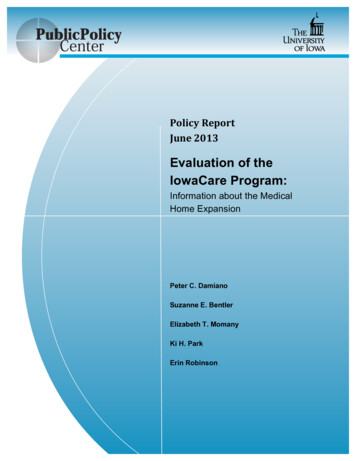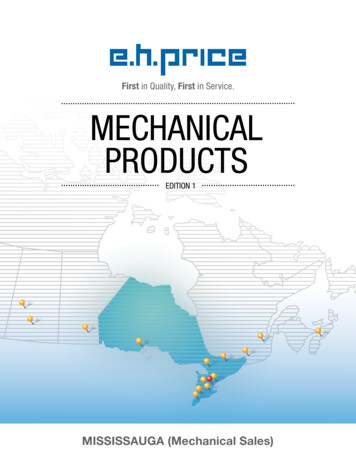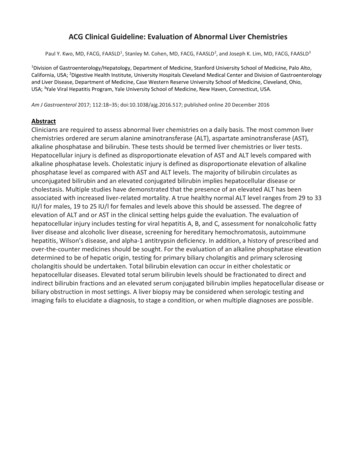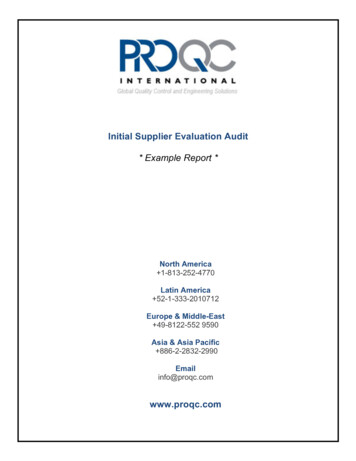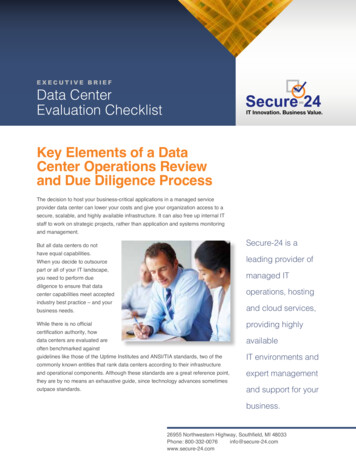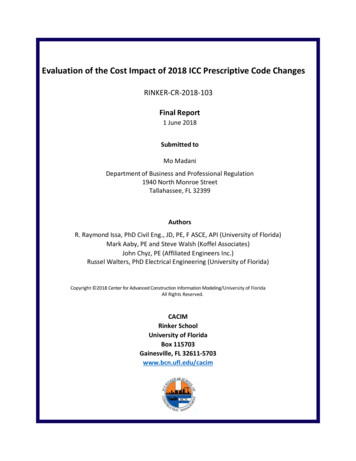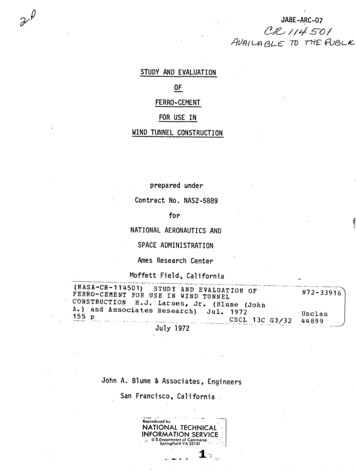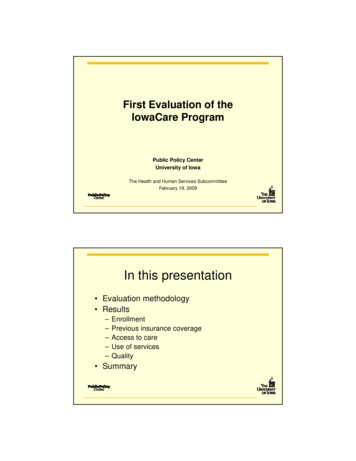
Transcription
First Evaluation of theIowaCare ProgramPublic Policy CenterUniversity of IowaThe Health and Human Services SubcommitteeFebruary 19, 2009In this presentation Evaluation methodology Results–––––EnrollmentPrevious insurance coverageAccess to careUse of servicesQuality Summary
Evaluation teamPeter C. DamianoDirector, Public Policy CenterElizabeth T. MomanyAssistant Director, Health Policy Research ProgramJean C. WillardSenior Research AssistantBelinda L. UdehResearch AssistantPublic Policy CenterKellee T. McCroryBrad B. RichardsonSchool of Social Work, Iowa Center for Evaluation ResearchNational Resource Center for Family Centered PracticeUniversity of IowaStarting point for evaluation IowaCare is a limited provider, limitedbenefit public insurance-model program– Providers: UIHC, Broadlawns and 4 MHIs– Benefits: Very limited dental DME, and Rxdrugs (generics provided by UIHC)– Insurance model: Premium-based (for thoseabove 100%FPL), not based on health needlike Indigent care program
Method of evaluation Enrollee perspective-surveys Administrative data-enrollment, use andoutcomes Provider perspective-focus groupsEnrollee perspective-surveys Instrument based on CAHPS 4.0– IowaCare specific questions added Written surveys-Spring 2008––––1600 Polk County/1600 rest of statePhone follow-ups to complete survey (ISU)Weighted to represent state population56% response rate Bias toward those older and women Designed to compare providers– UIHC VS Broadlawns
Administrative data IowaCare claims and enrollment filesused in the analyses Enrollment information– By age and gender– Re-enrollment Outcomes of careProvider perspectives Interviews and Focus Groups– University of Iowa Hospitals and Clinics– Broadlawns– Independence Mental Health Institute– Mt. Pleasant Mental Health Institute– Clarinda Mental Health Institute– Cherokee Mental Health Institute
Enrollment in IowaCareEnrollment issues Eligibility:– Adults 19-64 200%FPL,– Pregnant women 200-300%FPL,– Former state papers participants (grandfathered in) Enrollment exceeded expectations– Estimated 14,000– Now over 27,000 Over half worried about ability to pay premium
Enrollees per monthProportion of IowaCare enrollees tototal adult population by county, FY 2006-2007
Month of re-enrollmentPrevious insurance coverageMany without insurance for longperiod before IowaCare
Previous insurance coverage 2/3rds without insurance at least 2 yrs–––– 1 in 4 never had insurance40% employer-based13% Medicaid12% had been in Indigent Care Program90% had food assistance at some timeHealth status of enrolleesmany with chronic illnesses
Low enrollee health status-care usedTop 5 medical Hypertension Back pain Chest pain Resp. infections DiabetesTop 5 mental health Depression Anxiety Alcohol Manic/psychoses NeurosesLow enrollee health status-self report Much lower than for non-disabled Medicaidenrollees– 41% Fair or poor (11% Medicaid) Most common self-reported chronic conditions––––Mental health (depression-80%, anxiety-60%)Dental (43%)Back, neck, joint, arthritis (42%)Hypertension (39%)
Health status-self reportUtilization of servicesMixed message
Utilization of services 2/3rds had a personal doctor– ¼ at UIHC, 18% Broadlawns For most, this was a new personal doctor Most had a visit in previous 6 months– 19% had personal MD elsewhere More likely non-Polk ½ called for medical assistance– ¾ always or usually got help wantedUtilization of services 2/3rds had ED visit in previous 6 months– Mental health, chest pain, abdominal pain, back pain ½ needed urgent care in past 6 months– 1/3 went outside network (esp. non-Polk) 2/3rds had routine care visit– Half had a visit outside network ¼ no preventive visit past 3 years
Utilization of services Almost ½ tried to see specialist (80% did)– Polk residents came to UIHC more than for other care 15% hospitalized past 6 months ¾ needed Rxs– 90% for chronic condition– 2/3rds got them from UIHC/Broadlawns 10% needed DME (1/2 got it) 20% tried to get dental (more Polk)– ½ outside Polk successful (80% in Polk)Utilization-claims data Younger enrollees were more likely to use ERthan older enrollees Older enrollees were more likely to useoutpatient care, inpatient care, and outpatientsurgeryCould be due to previous link to services orchronic nature of problems in older enrollees
Use of ambulatory health servicesAccess to careMixed message
Access issues studied Unmet need routine care-33%– 18% Polk, 42% non-Polk Got appointments as soon as needed– 67% always/usually– 33% sometimes/never Unmet need specialty care-37% of w/need Unmet need preventive care-23% Unmet need mental health care-39% of w/needReasons stopped routine care
Reasons stopped mental health careAccess to care2/3-1/3 rule Routine care– 1/3 unmet need-cost, travel, appt. (Polk) Urgent care– 1/3 delayed, more likely if go outside network Specialist– 1/3 unmet need Mental health– 40% unmet need
Quality of careQuality of care All care rated same UIHC/Broadlawns– Slightly lower than for Medicaid Personal MD rated higher Broadlawns– Time with patient a factor Specialists, hospital care rated higher at UIHC
Recommend IowaCare to othersProvider perspectives fromfocus groups
Provider perceptions Application easy except– Birth certificate requirement– Verification of eligibility. Physicians have very little or no interactionwith the IowaCare program regardingcoverage.Provider perceptions Social workers working with patients onaftercare/discharge. Reaching services location and logistics Lack of coverage for pharmaceuticals, durablemedical equipment, vision, dental and continuingcare (nursing homes), and mental healthservices.
Provider perceptions-treatment All patients received the care they need for thepresenting issue Issues with referrals to UIHC specialty clinics Practice guidelines and protocols reported to bethe same for all patients, regardless of insurance Medications are prescribed generic unless thereis a medical reason to prescribe name-brandProvider perceptions-specific MHIs– Shortage of psychiatrists in Iowa UIHC– Concern about payment for hospital care butnot for physician services– Clinic volume greater than anticipated
Summary Enrolling very sick population Many previously uninsured for a long time Program meeting needs of 2/3rds prettywell– 1/3 have issues with cost, access– Those outside Polk County have more issues Polk have more unmet needs from trouble gettingappointments-delays more likely at UIHC
– Providers: UIHC, Broadlawns and 4 MHIs – Benefits: Very limited dental DME, and Rx drugs (generics provided by UIHC) – Insurance model: Premium-based (for those above 100%
